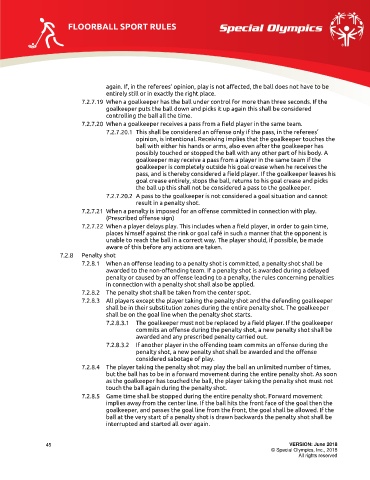Page 297 - Revised Unified Sports Curriculum electronic version Rev. 8.1_2
P. 297
FLOORBALL SPORT RULES
again. If, in the referees’ opinion, play is not affected, the ball does not have to be
entirely still or in exactly the right place.
When a goalkeeper has the ball under control for more than three seconds. If the
goalkeeper puts the ball down and picks it up again this shall be considered
controlling the ball all the time.
When a goalkeeper receives a pass from a field player in the same team.
This shall be considered an offense only if the pass, in the referees’
opinion, is intentional. Receiving implies that the goalkeeper touches the
ball with either his hands or arms, also even after the goalkeeper has
possibly touched or stopped the ball with any other part of his body. A
goalkeeper may receive a pass from a player in the same team if the
goalkeeper is completely outside his goal crease when he receives the
pass, and is thereby considered a field player. If the goalkeeper leaves his
goal crease entirely, stops the ball, returns to his goal crease and picks
the ball up this shall not be considered a pass to the goalkeeper.
A pass to the goalkeeper is not considered a goal situation and cannot
result in a penalty shot.
When a penalty is imposed for an offense committed in connection with play.
(Prescribed offense sign)
When a player delays play. This includes when a field player, in order to gain time,
places himself against the rink or goal café in such a manner that the opponent is
unable to reach the ball in a correct way. The player should, if possible, be made
aware of this before any actions are taken.
Penalty shot
When an offense leading to a penalty shot is committed, a penalty shot shall be
awarded to the non-offending team. If a penalty shot is awarded during a delayed
penalty or caused by an offense leading to a penalty, the rules concerning penalties
in connection with a penalty shot shall also be applied.
The penalty shot shall be taken from the center spot.
All players except the player taking the penalty shot and the defending goalkeeper
shall be in their substitution zones during the entire penalty shot. The goalkeeper
shall be on the goal line when the penalty shot starts.
The goalkeeper must not be replaced by a field player. If the goalkeeper
commits an offense during the penalty shot, a new penalty shot shall be
awarded and any prescribed penalty carried out.
If another player in the offending team commits an offense during the
penalty shot, a new penalty shot shall be awarded and the offense
considered sabotage of play.
The player taking the penalty shot may play the ball an unlimited number of times,
but the ball has to be in a forward movement during the entire penalty shot. As soon
as the goalkeeper has touched the ball, the player taking the penalty shot must not
touch the ball again during the penalty shot.
Game time shall be stopped during the entire penalty shot. Forward movement
implies away from the center line. If the ball hits the front face of the goal then the
goalkeeper, and passes the goal line from the front, the goal shall be allowed. If the
ball at the very start of a penalty shot is drawn backwards the penalty shot shall be
interrupted and started all over again.
45 VERSION: June 2018
© Special Olympics, Inc., 2018
All rights reserved

